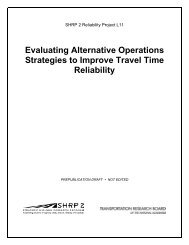Annotated Bibliography - SSTI
Annotated Bibliography - SSTI
Annotated Bibliography - SSTI
Create successful ePaper yourself
Turn your PDF publications into a flip-book with our unique Google optimized e-Paper software.
Title<br />
Models to Predict the Economic Development Impact of Transportation Projects:<br />
Historical Experience and New Applications<br />
Authors Glen Weisbrod<br />
Sponsor Economic Development Research Group (EDR Group)<br />
Date December, 2007<br />
Pages 25<br />
Category Economic Performance Measures, Modes: All<br />
Note<br />
Online<br />
Summary<br />
http://www.edrgroup.com/edr1/bm~doc/models‐to‐predict‐the‐eco.pdf<br />
This article provides a historical overview of the connection between transportation<br />
and economics, beginning in Roman times and ending with current computerized<br />
modeling. It explains that "predictive impact models used for decision‐making should be<br />
sensitive to causal factors and elements of access impact known to make a difference in<br />
the effect of transportation projects on regional economic growth and development".<br />
Discusses a shift from a primary focus on economic benefits of time and cost savings to<br />
broader functions of economic development such as accessibility roles in supply chains,<br />
labor market expansion, and global trade growth.<br />
The report explains how several classes of models have been implemented over time in<br />
order to assess economic development and transportation. These include impact<br />
models, land use‐development models, macro‐economic models, regional economic<br />
simulation models, and local access models. The report examines each of these types<br />
and provides a detailed history of a computer based model for each. For instance, it<br />
provides an in depth account of REMI Policy Insight (REMI‐PI) to demonstrate a regional<br />
simulation model. The first application of the model was to assess transportation and<br />
calculate the economic growth impacts of business cost changes for a proposed<br />
highway in Wisconsin in 1988. At this time, it was concluded that other models need to<br />
be applied along with REMI‐PI in order to yield the most accurate results and an<br />
economic geography element was added that modifies regional purchasing patterns<br />
dependent on changes in generalized commodity access and labor access indices.<br />
<strong>Annotated</strong> <strong>Bibliography</strong> Page 38















